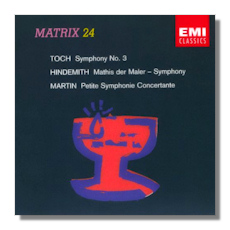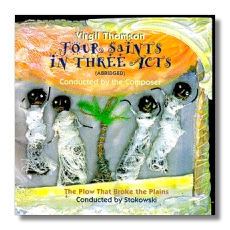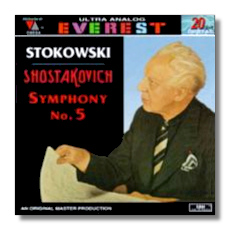
The Internet's Premier Classical Music Source
Related Links
- Latest Reviews
- More Reviews
-
By Composer
-
Collections
DVD & Blu-ray
Books
Concert Reviews
Articles/Interviews
Software
Audio
Search Amazon
Recommended Links
Site News
 CD Review
CD Review
Stokowski and 20th-Century Music

- Frank Martin: Petite Symphonie Concertante
- Ernst Toch: Third Symphony *
- Paul Hindemith: Mathis der Maler *
Stokowski's Symphony Orchestra/Leopold Stokowski
* Pittsburgh Symphony Orchestra/William Steinberg
EMI Matrix #24 65868 Stereo 1957


Virgil Thomson
- The Plow that Broke the Plains
- Four Saints in Three Acts*
Hollywood Bowl Symphony Orchestra/Leopold Stokowski
* Hollywood Bowl Symphony Orchestra/Virgil Thomson
RCA Gold Seal 68163 Mono 1946, * 1947


Dmitri Shostakovich
Symphony #5
Stadium Symphony Orchestra of New York/Leopold Stokowski
Everest EVC9030 Stereo 1958
These discs are listed in the order in which they were released. All of them were released in February/March of 1996.
Stokowski conducted the U.S. or World premières of over 200 works. They range from the Elgar Symphony #2 (Cincinnati, 1911) to Brian's 28th Symphony (New Philharmonia, 1973). This thought crossed my mind as I began to review these releases. Here we have prime examples of Stokowski's efforts to promote "new" music. We also have prime examples of what can happen to it.
Shostakovich, of course, is now considered one of the great composers of this century. Martin and Thomson, to be frank, are not. Still, these discs have much to offer and contemplate.
Let me begin with the Thomson. I do so because I consider this disc a memorial to Jack Pfeiffer who passed away just a couple days after sending me this CD. He was also involved in its issue on compact disc. It is, of course, part of RCA's part in the centenary of Thomson's birth. It is also odd for two reasons. First, these are historic issues and that is, in itself, especially in the case of Thomson, rare. Second, this historic release comes wrapped in a package that in no way would catch the attention of someone interested in historic releases. The cover features four figures that look like voodoo dolls in some kind of gumby-like locale. The contents, however, are of interest.
I will not offer my opinions on the Four Saints in Three Acts conducted by the composer. Frankly, I don't like it but I don't like a lot of vocal music. The Stokowski recording of The Plow that Broke the Plains, however, is more than just interesting. First of all, the sound is remarkable for its time. In fact, it is the best sounding Hollywood Bowl SO recording I have ever heard! There is absolutely NO surface noise and it make me wonder if they had used an early form of tape. There is no information on the disc regarding the remastering, but I later found that it was done by Ward Marston (he was not credited because he did only the Stokowski recording). Ward has done a remarkable job!! There is NO surface noise at all!! This is much like the work of Michael Dutton, but Ward's transfer has more air around the music. Stokowski also recorded this in stereo with the Symphony of the Air (Toscanini's NBC Symphony Orchestra after NBC jettisoned them). The comparisons are interesting. This 1946 recording sounds more like a movie score (as well it should) whereas the later recording is more 'symphonic'. It is also obvious that the SOA was a much better orchestra than the HBoston Symphony Orchestra. But the brass in the HBoston Symphony Orchestra can't be beat and that orchestra seems to have a better feel for the jazz in the fourth movement: Speculation (Blues). So, this is more of historical interest for Stokowski fans and, I would guess, for admirers of Thomson. But how often are these pieces recorded today? Will we see some tribute recordings?
The next disc contains the music of Frank Martin, Petite Symphony Concertante [it should have added, for harp and harpsichord to differentiate it from the later version of the composer]. This was recorded with HIS SO, an ad hoc group of musicians drawn mostly from the New York Philharmonic. The sound here is another lesson in Stokowski manipulating the recording to achieve his sound. The orchestra itself usually numbered only around 60 players. By adding reverberation to the tape Stokowski was able to get it to sound like a much larger body, especially in the strings. The piece opens up reminding you of Schoenberg's Verklärte Nacht (as well it should since Martin admired Schoenberg) and in places sounds a bit like Poulenc's Harpsichord Concerto. It is very pretty, but I can't say it is great music. In fact, I would recommend it primarily for the recording of Toch's Symphony #3 with William Steinberg conducting the Pittsburgh Symphony. There's a piece of music that I do not understand why it is neglected today. It has oriental flavor in the first movement that brings to mind Shostakovich. This is the first CD incarnation of the Martin.
Now we turn from two composers who have become little more than footnotes in the history of 20th Century music to one of the greatest musicians from our time. Dmitri Shostakovich's Fifth Symphony was first recorded by Stokowski and the Philadelphia Orchestra (in 1935). Stokowski performed the work many times in concert. One of those occasions can be heard with the London Symphony in 1964 on Music and Arts 765 (it has also been released on IMP's BBC series just recently, but I have not heard that recording). He recorded it in stereo with the Stadium Symphony Orchestra of New York (NYPO in summer garb) in 1959. This recording has been previously released on Philips and PriceLess.
I gave away the Philips disc some years ago. The Cedaring process used sucked all the air and life from the recording. The Price Less disc was much more full and reverberant. In fact, its opening grabs you by the throat! I used that release for comparison and found it interesting.
The Price Less disc has a more powerful opening and that is not just a matter of a higher transfer level. After that, however, it is all to the favor of this Everest release. The engineers have done a wonderful job of remastering the disc. There is much more of a 'front-to-back' sense of the sound. Details abound that are buried in the haze of the Price Less disc. There is an intimate, almost chamber-music like quality to the performance. In every way this is more involving and one of the best efforts by Everest/ Vanguard/Omega to date. The memory of Bert Whyte has been proudly served with this release.
Now the bad news. There is no coupling with the disc and I know it is a mid- range priced disc. For those of you who love Stokowski the disc is a must. For those who love Shostakovich it is one of the finest performances and the sound will compare with any digital release. Unfortunately, some people will simply note the 44 minutes duration and look elsewhere. That is too bad, they will have missed a great performance.
For the sake of it, I also compared this recording with Stokowski's first one with the Philadelphia. This is on a two-disc set with the First and 7th Symphonies (Pearl 9044). The remastering of the 5th is by Mark Obert-Thorn, who did the work for the L.S.S.A. when we issued the LP some years ago. Naturally, you can't expect the 1939 recording to have the kind of inner detail of the stereo recording, but you might be surprised how much music Mark was able to find in those 78s. The Philadelphia Orchestra is obviously far better than the New York Philharmonic of 1958. The sound is darker, but not more sinister, than in the Everest recording. The orchestra's attacks are sharper and more crisp. On the other hand, the strings in the Everest recording are more articulate and poignant. I would not want to be without either, but have to say that for repeated listening the Everest is involving in the best sense of that term. It sucks you into the performance and leaves you sighing as each movement comes to a close.
"Today is the good old days" read the sign over the pipe shop I frequented in the 70s. When these recordings were made the composers were alive and working. Stokowski liked their music enough to record his feelings. I look at all the contemporary music there is on orchestra programs compared with just a few years ago. How much will the contemporary become contemporary. I am not passing any judgments, but I do know which of these discs I'll most likely reach for most often.
Later: and in fact have. I just recently received a copy of this symphony on EMI with Marris Jansons conducting. Janson's interpretation is more swift than Stokowski's and it is an exciting one. I found myself breathless at the climax in the first movement. The final movement has all of the 'in your face' irony mentioned in Testimony. This is a hollow victory.
Stokowski's interpretation is pre-Testimony but really better than Jansons'. The remastered sound in this disc is more involving than the EMI. It is almost as if Stokowski had been listening to Shostakovich's Quartets and saw this symphony in that light. The interplay of the orchestra catches my attention again and again. There is a more oriental atmosphere here than in any other interpretation. The strings have more of a poignancy than the Oslo Philharmonic. In all, this is my favorite recording of this masterpiece and arguably one of the best ever.
Copyright © 1996, Robert Stumpf II


















